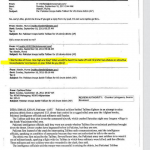DOJ: No contempt charges for former IRS official Lois Lerner
The Justice Department will not seek criminal contempt charges against former IRS official Lois Lerner, the central figure in a scandal that erupted over whether the tax agency improperly targeted conservative political groups.
Ronald Machen, the former U.S. attorney for the District of Columbia, told House Speaker John Boehner (R-Ohio) in a seven-page letter this week that he would not bring a criminal case to a grand jury over Lerner’s refusal to testify before the House Oversight and Government Reform Committee in March 2014. The House approved a criminal contempt resolution against Lerner in May 2014, and Machen’s office has been reviewing the issue since then.
Lerner and other IRS officials, however, are still under investigation by the FBI for the tea party targeting matter — which is a separate probe entirely.
Lerner cited her Fifth Amendment right not to incriminate herself during congressional testimony on March 5, 2014, although then-Oversight Chairman Rep. Darrell Issa (R-Calif.) said she had waived that right by giving an opening statement at a hearing 10 months earlier when she asserted her innocence. Issa wanted her charged by the Justice Department with criminal contempt of Congress for failing to answer questions about her role in the scandal.
Machen said the Oversight Committee “followed proper procedures” in telling Lerner that it had “rejected her claim of privilege and gave her an adequate opportunity to answer the committee’s questions.”
However, Machen said DOJ lawyers determined that Lerner “did not waive her Fifth Amendment right by making an opening statement on May 22, 2013, because she made only general claims of innocence.”
Machen added: “Given that assessment, we have further concluded that it is not appropriate for a United States attorney to present the matter to the grand jury for action where, as here, the Constitution prevents the witness from being prosecuted for contempt.”
Lerner, unsurprisingly, was pleased by the announcement. “Anyone who takes a serious and impartial look at this issue would conclude that Ms. Lerner did not waive her Fifth Amendment rights,” said Lerner’s attorney, William Taylor III, in a statement. “It is unfortunate that the majority party in the House put politics before a citizen’s constitutional rights.”
“Ms. Lerner is pleased to have this matter resolved and looks forward to moving on with her life,” Taylor added.
Republicans were disappointed by the decision not to move ahead.
“Once again, the Obama administration has tried to sweep IRS targeting of taxpayers for their political beliefs under the rug,” said Boehner spokesman Michael Steel, urging the White House to “do the right thing and appoint a special counsel to examine the IRS’ actions.”
Rep. Mark Meadows (R-N.C.), one of several House Oversight Committee members who says Justice has failed to take the IRS matter seriously, said the decision “offers little assurance to the American taxpayer that the department is actually investigating this abuse of power.”
Rep. Jim Jordan (R-Ohio), who led the IRS probe in the House, knocked Machen in a statement for “us[ing] his power as a political weapon to undermine the rule of law.”
“Mr. Machen … unilaterally decided to ignore the will of the House of Representatives,” Jordan said. “He and the Justice Department have given Lois Lerner cover for her failure to account for her actions at the IRS.”
Lerner, who led the IRS unit that subjected conservative nonprofits to additional scrutiny, quickly became the face of the scandal when she revealed the practice during an obscure tax conference on May 9, 2013. At the time, Lerner and the IRS blamed “frontline” employees in the agency’s Cincinnati office for any violations, though later it became clear that IRS headquarters in Washington, D.C., was holding up approval of the nonprofit groups’ tax status for years at time.
When initially summoned to Capitol Hill to answer for the scandal in May 2013, Lerner took the Fifth Amendment and refused to answer questions. Lawmakers would eventually hold her in contempt of Congress when she, again, asserted her Fifth Amendment privilege at the second hearing in March 2014.
GOP investigators on both the House Oversight and the Ways and Means committees have released numerous emails showing Lerner’s liberal political leanings. They’ve accused her of bias in the workplace, including using her position to try to persuade IRS auditors to probe and reject the nonprofit application for Karl Rove’s influential Crossroads GPS.
Republicans also noted Lerner’s private skepticism of political nonprofits, which are governed by complex rules originally designed to limit their direct role in elections. Republicans assert that Lerner tried to use her division to crack down on conservative political groups, something Democrats had been urging the IRS to consider.
Last June, more than a year into the investigation, the IRS announced it lost two years’ worth of Lerner’s emails in a 2011 computer crash. The agency said the emails were not recoverable because it had recycled her hard drive and written over relevant backup tapes.
The IRS inspector general later proved the agency wrong, unearthing backup tapes that investigators believe include the correspondence.
Lerner maintains her innocence and argues she was only doing her job — ensuring nonprofits follow the rules. Though Lerner refused to talk to lawmakers during the probe, her lawyer said Lerner cooperated with the FBI, answering its questions as needed. The results of the fuller FBI investigation are expected soon.
Lerner has given only one interview with the press, an exclusive with POLITICO, in which she talked about how the scandal has changed her life dramatically, including making her the object of public scorn. Even then, Lerner, at the behest of her attorneys, refused to answer specific questions about her role in the whole practice.

